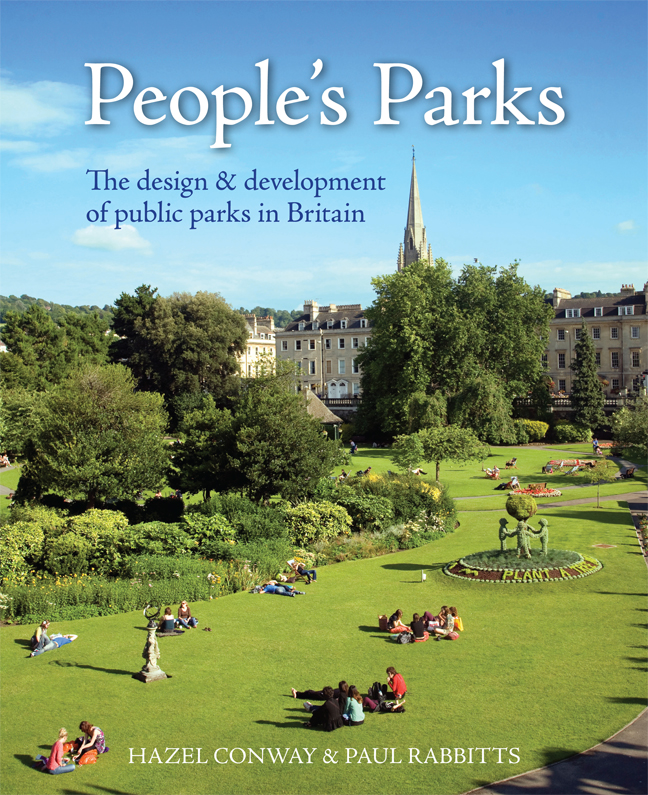Book contents
- Frontmatter
- Dedication
- Contents
- Miscellaneous Frontmatter
- Preface
- Acknowledgements
- Foreword
- A Word from Parks Professionals, Politicians and Parks Organisations
- Introduction: Dr Hazel Conway (1991)
- 1 Public Parks and Municipal Parks
- 2 The Need for Parks
- 3 Pioneering Parks Development
- 4 The Park Movement
- 5 Design and Designers
- 6 Lodges, Bandstands and the Cultivation of Virtue
- 7 Local Pride and Patriotism
- 8 Planting and Park Maintenance
- 9 Permitted Pastimes
- 10 Recreation Grounds, Parks and the Urban Environment
- 11 Public Parks, 1885–1914
- 12 Later Municipal Park Designers
- 13 Garden Cities and the New Towns Movement
- 14 Sport, Physical Activity and Recreation in Public Parks in the Inter-war Years
- 15 Parks Management – a Changing Perspective
- 16 Decline, Revival and Renewal – the Role of Parks into 21st-century Britain
- Appendix 1 Summary of main legislation promoting early park development
- Appendix 2 Chronology of main municipal and public park developments between 1800 and 1885
- Notes
- Bibliography
- Subscription List
- Index
7 - Local Pride and Patriotism
Published online by Cambridge University Press: 22 February 2024
- Frontmatter
- Dedication
- Contents
- Miscellaneous Frontmatter
- Preface
- Acknowledgements
- Foreword
- A Word from Parks Professionals, Politicians and Parks Organisations
- Introduction: Dr Hazel Conway (1991)
- 1 Public Parks and Municipal Parks
- 2 The Need for Parks
- 3 Pioneering Parks Development
- 4 The Park Movement
- 5 Design and Designers
- 6 Lodges, Bandstands and the Cultivation of Virtue
- 7 Local Pride and Patriotism
- 8 Planting and Park Maintenance
- 9 Permitted Pastimes
- 10 Recreation Grounds, Parks and the Urban Environment
- 11 Public Parks, 1885–1914
- 12 Later Municipal Park Designers
- 13 Garden Cities and the New Towns Movement
- 14 Sport, Physical Activity and Recreation in Public Parks in the Inter-war Years
- 15 Parks Management – a Changing Perspective
- 16 Decline, Revival and Renewal – the Role of Parks into 21st-century Britain
- Appendix 1 Summary of main legislation promoting early park development
- Appendix 2 Chronology of main municipal and public park developments between 1800 and 1885
- Notes
- Bibliography
- Subscription List
- Index
Summary
Public parks provide space for marking local, national and international events and achievements. A visit by the queen, the virtues of particular individuals, the achievements of industry and local government, and Britain's imperial role were celebrated, sometimes in very ingenious ways. The most readily recognisable characters on that stage were those whose statues commanded prominent positions: royalty, MPs, benefactors, dignitaries and local heroes.
By mid-century the expanding railway network was making travel quicker, safer and far less exhausting and, until the death of Prince Albert in 1861, Queen Victoria travelled extensively throughout the kingdom, visiting towns and opening new buildings and parks. Such visits were cause for great local celebration, to be remembered with pride. The statues of the queen that were erected in public parks during the 1850s and 1860s were commissioned largely, if not wholly, in response to a royal visit. On the occasion of her first visit to Peel Park, Salford, in 1851, the queen was greeted by more than 80,000 children and their teachers, and a marble statue sculpted by Matthew Noble was erected. The second visit, in 1857, was commemorated by the building of the Victoria Arch. Similarly, when the queen and Prince Albert visited Pearson Park, Hull, in 1854, the event was commemorated by two statues, that of the queen being unveiled in 1863 and that of the Prince Consort sometime later.
After the death of the Prince Consort the queen went into deep mourning and was rarely seen, except to unveil memorials to him. Salford was one of the first towns to consider erecting a memorial to Prince Albert, and the statue, by Matthew Noble, was unveiled in 1864. In the 1870s the queen began to resume public life, and Birmingham was among the places she visited in 1877, in order to lay the first stone of the new law courts. She arrived by train at Small Heath station and was first driven slowly round Small Heath Park, before going on to the city centre. The public were excluded from the park that day, but the 7-metre-wide carriage drive was lined by nearly 50,000 cheering children. This event was commemorated by renaming the park Victoria Park and by a stained-glass window in the Great Hall of the law courts, which showed the scene in the park.
Information
- Type
- Chapter
- Information
- People's ParksThe design & development of public parks in Britain, pp. 117 - 134Publisher: Boydell & BrewerPrint publication year: 2023
